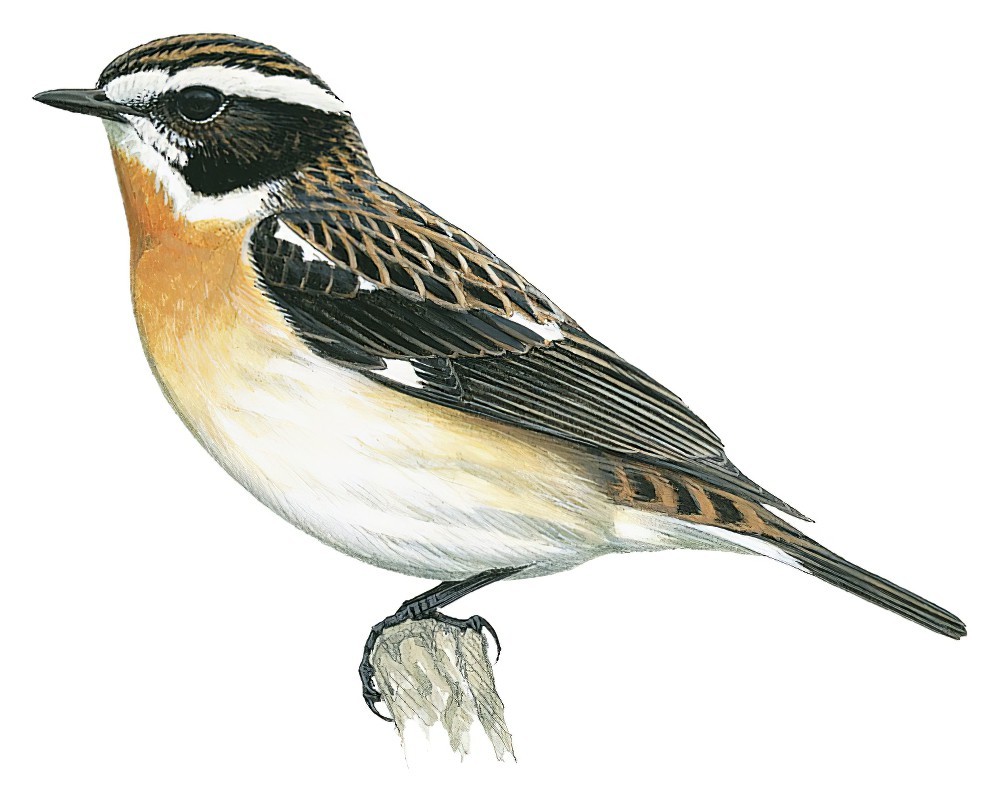Whinchat / Saxicola rubetra

Whinchat
SCI Name:
Protonym: Motacilla Rubetra Syst.Nat.ed.10 p.186
Taxonomy: Passeriformes / Muscicapidae / Saxicola
Taxonomy Code: whinch1
Type Locality: Europa [= Sweden].
Author: Linnaeus
Publish Year: 1758
IUCN Status: Least Concern
DEFINITIONS
SAXICOLA
(Muscicapidae; Ϯ Common Stonechat S. torquatus rubicola) L. saxum, saxi stone; -cola dweller < colere to inhabit; "Gattung. Steinschmätzer. Saxicola. ... Sie machen den schicklichsten Uebergang zu den Fliegenfängern nach Gestalt und Lebensart; nisten auf der Erde oder in Löchern, und fressen blos Insekten, und zwar Käferarten und Fliegen. *1. Großer Steinschmätzer (S. Oenanthe). ... *2. Braunkehliger Steinschmätzer (S. Rubetra). ... Ϯ3. Schwarzkehliger Steinschmätzer (S. Rubicola)" (Bechstein 1802); “Bechstein’s genus Saxicola ... contains three species only: œnanthe (Wheatear), rubetra (Whinchat), and rubicola (Stonechat). No type was originally designated, but Swainson (Zoologist Journ. iii. 1827, p. 172) subsequently fixed as the type Motacilla rubicola. Gray in 1841 and Seebohm (Cat. Bds. B. M. v. 1881, p. 362) made “œnanthe” the type; there can be no doubt, however, that Swainson’s designation must stand, and another name be found for the Wheatears” (BOU 1915); "Saxicola Bechstein, 1803, Orn. Taschenb., (1802), p. 216. Type, by subsequent designation (Swainson, 1827, Zool. Journ., 3, p. 172), Motacilla rubicola Linnaeus." (Ripley in Peters 1964, X, 104). Some workers believe that this form could be split into as many as seven species (i.e. S. torquatus, S. rubicola, S. maurus, S. przewalskii, S. stejnegeri, S. albofasciatus, S. sibilla).
Var. Laxicola.
Synon. Curruca, Fruticicola, Pratincola, Rhodophila, Rubetra.
● (syn. Oenanthe Ϯ Northern Wheatear O. oenanthe) Formerly this name was much used for the wheatears and similar chat-like species (see above).
saxicola
L. saxum, saxi stone, rock; -cola dweller < colere to inhabit.
rubetra
● Albin’s 1731, name “Rubetra” for the Whinchat. Many early authors, including Linnaeus, confused the Whinchat and the Western Stonechat, using rubetra as a translation of Aristotle’s βατις batis a grub-eating bird, with ref. to the chats’ habitat (Gr. βατος batos bramble; L. rubus bramble ); "99. MOTACILLA. ... Rubetra. 18. M. nigricans, superciliis albis, macula alarum alba, gula pectoreque flavescente. Fn. svec. 218. & 230. t. 1. f. 3, 4. Muscicapa s. Oenanthe tertia. Aldr. orn. 735. Raj. av. 76. n. 4. Will. orn. 169. t. 41. f. 5. Curruca major altera. Frisch. av. . t. 22. f. 2. Rubetra. Alb. av. I. p. 50. t. 52. Ficedula s. Atricapilla alia. Jonst. av. . t. 45. f. ult. Ficedula 3. aldrovandi. Edw. av. 30. t. 30. Habitat in Europa." (Linnaeus 1758) (Saxicola) (see Batis).
● Late Med. L. rubetra small bird identified with the Stonechat Saxicola by Gaza 1476, and Turner 1544; the “Chat-like Pepoaza” of Hellmayr 1927 (Xolmis).
Rubetra
● (syn. Saxicola Ϯ Whinchat S. rubetra) Specific name Motacilla Rubetra Linnaeus, 1758; "The redstart's song considerably resembles that of the migrant furze-chat or "whinchat" of authors (saxicola-rubetra migratoria), consisting of short and rather plaintive detached staves" (Blyth 1836).
● (syn. Saxicola Ϯ Common Stonechat S. torquatus rubicola) Late Med. L. rubetra small bird identified with the Stonechat by Gaza 1476 and Turner 1544; "A variety of small black-headed birds are designated in different parts of Britain by the term Blackcap. The great titmouse (Parus fringillago), the marsh titmouse (P. palustris), the black-headed or reed bunting (Emberiza schœniclus), the stonechat (Rubetra rubicola), and even the black-headed gull, are all frequently called by this name" (Partington 1834).
UPPERCASE: current genus
Uppercase first letter: generic synonym
● and ● See: generic homonyms
lowercase: species and subspecies
●: early names, variants, mispellings
‡: extinct
†: type species
Gr.: ancient Greek
L.: Latin
<: derived from
syn: synonym of
/: separates historical and modern geographic names
ex: based on
TL: type locality
OD: original diagnosis (genus) or original description (species)












